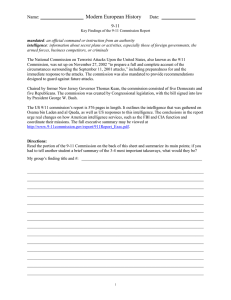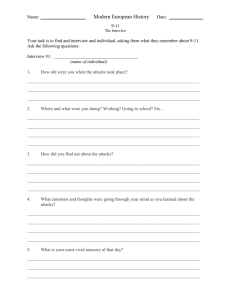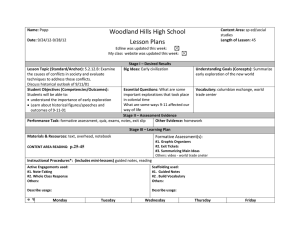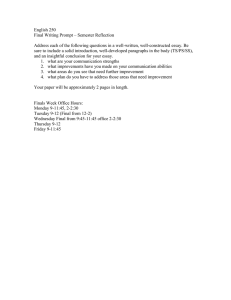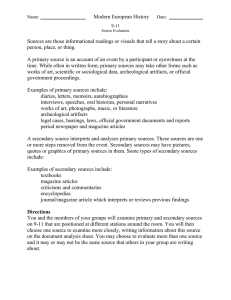PrepUS History Name: ____________________ Date: _______________
advertisement
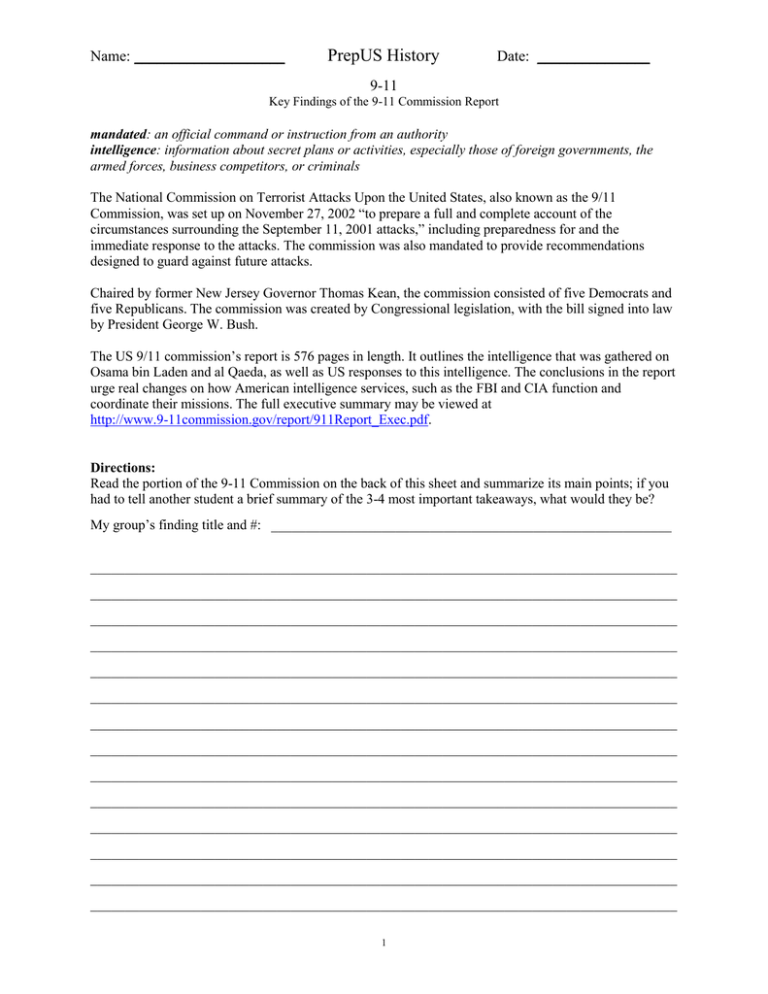
Name: ____________________ PrepUS History Date: _______________ 9-11 Key Findings of the 9-11 Commission Report mandated: an official command or instruction from an authority intelligence: information about secret plans or activities, especially those of foreign governments, the armed forces, business competitors, or criminals The National Commission on Terrorist Attacks Upon the United States, also known as the 9/11 Commission, was set up on November 27, 2002 “to prepare a full and complete account of the circumstances surrounding the September 11, 2001 attacks,” including preparedness for and the immediate response to the attacks. The commission was also mandated to provide recommendations designed to guard against future attacks. Chaired by former New Jersey Governor Thomas Kean, the commission consisted of five Democrats and five Republicans. The commission was created by Congressional legislation, with the bill signed into law by President George W. Bush. The US 9/11 commission’s report is 576 pages in length. It outlines the intelligence that was gathered on Osama bin Laden and al Qaeda, as well as US responses to this intelligence. The conclusions in the report urge real changes on how American intelligence services, such as the FBI and CIA function and coordinate their missions. The full executive summary may be viewed at http://www.9-11commission.gov/report/911Report_Exec.pdf. Directions: Read the portion of the 9-11 Commission on the back of this sheet and summarize its main points; if you had to tell another student a brief summary of the 3-4 most important takeaways, what would they be? My group’s finding title and #: __________________________________________________________ _____________________________________________________________________________________ _____________________________________________________________________________________ _____________________________________________________________________________________ _____________________________________________________________________________________ _____________________________________________________________________________________ _____________________________________________________________________________________ _____________________________________________________________________________________ _____________________________________________________________________________________ _____________________________________________________________________________________ _____________________________________________________________________________________ _____________________________________________________________________________________ _____________________________________________________________________________________ _____________________________________________________________________________________ _____________________________________________________________________________________ 1 Name: ____________________ PrepUS History Date: _______________ 9-11 Key Findings of the 9-11 Commission Report preceded: to happen before somebody or something else in time, position, or importance foiled: to prevent somebody from succeeding in something Key findings of the 9/11 Commission Report 1. Development of al-Qaeda Al-Qaeda was allowed to develop into a significant danger to the US, concluding that while the attacks “were a shock... they should not have come as a surprise as Islamist extremists had given plenty of warning that they meant to kill Americans indiscriminately and in large numbers.” • “The 9/11 attack was driven by Osama bin Laden” who “built over the course of a decade a dynamic and lethal organization” in al-Qaeda. • Events that preceded 9/11 that give indication that “Islamists were determined to kill Americans indiscriminately” included: a. 1993 bombing of the World Trade Center; b. Foiled plot to blow up the Holland and Lincoln Tunnels and other New York landmarks; c. 1993 Somali “Black Hawk Down” battle that killed 18 and wounded 73, were assisted by al Qaeda; d. 1995 Ramzi Yousef plot to blow up dozens of US airliners flying over the Pacific; e. 1996 Riyadh, Saudi Arabia car bombing that killed 5 Americans; f. 1996 truck bombing of Khobar Towers, Saudi Arabia that killed 19 US servicemen and wounded hundreds of others (though this was carried out with Iranian backed Hezbollah group); g. 1998 attacks on US embassies in Tanzania and Kenya, killing 12 American and 224 others; h. 1999 foiled attack on Jordanian hotels frequented by Americans; i. 2000 foiled “ium” plot on the Los Angeles International Airport; and j. 2000 attack on the U.S.S. Cole that killed 17 American sailors. • “What we can say with confidence is that none of the measures adopted by the US government from 1998 to 2001 disturbed or even delayed the progress of the al-Qaeda plot.” 2 Name: ____________________ PrepUS History Date: _______________ 9-11 Key Findings of the 9-11 Commission Report deterred: to discourage somebody from taking action or prevent something from happening, especially by making somebody feel afraid or anxious no-fly lists: a list created and maintained by the US Terrorist Screening Center (TSC) of people who are not permitted to board a commercial aircraft for travel in or out of the United States Key findings of the 9/11 Commission Report 2. Missed opportunities The report finds that the 9/11 plot might have been interrupted and deterred had the security services done their work more thoroughly. However, it accepts that “since the plotters were flexible and resourceful, we cannot know whether any single step or series of steps would have defeated them.” The report accuses “organizations and systems of that time” of: • Developing and planning to use the missile-equipped Predator aircraft to target bin Laden and his chief lieutenants. Those plans were on President Bush’s desk awaiting his signature on September 11, 2001. • Allowing two hijackers, Khalid al-Midhar and Nawaq Alhamzi, to enter and move about the US without proper surveillance despite their known links to al-Qaeda. • “Not linking the arrest of Zacarias Moussaoui, described as interested in flight training for the purpose of using an airplane in a terrorist act, to the heightened indications of attack.” • Not discovering false statements on visa applications and not recognizing faked passports. • Not expanding no-fly lists to include names from terrorist watch lists and not searching airline passengers identified by computer-based screening. • Not hardening aircraft cockpit doors or taking other measures to prepare for the possibility of suicide hijackings. 3 Name: ____________________ PrepUS History Date: _______________ 9-11 Key Findings of the 9-11 Commission Report unprecedented: having no earlier parallel or equivalent; never happened before domestically: events, plans, policies, etc. occurring within a country (not foreign) “millennium” alert: the coding of computerized systems was projected to create major problems with computers and computer networks around the world at the beginning of the year 2000. It was feared that failures would occur in computers used in banking, utilities systems, government records, etc., with the potential for widespread chaos on and following January 1, 2000. After more than a year of international alarm, feverish preparations, and programming corrections, few major failures occurred. Key findings of the 9/11 Commission Report 3. Open to attack While praising the response of members of the emergency services to the attacks, the report finds institutional weaknesses within the US which both made it easier for extremists to attack and harder for the authorities to respond adequately: • During the abbreviated transition time from Clinton to the Bush administration, military options for dealing with bin Laden in Afghanistan remained unappealing. As summer 2001 reports that something “very, very big” was being planned, all indicators pointed overseas, where security was buffed up, but not domestically. The threat did not receive media attention comparable to the “millennium” alert. • “The hijackers had to beat only one layer of security - the security checkpoint process. Once on board, the hijackers were faced with aircraft personnel who were trained to be non-confrontational in the event of a hijacking.” • “The civilian and military defenders of the nation’s airspace attempted and failed to improvise an effective homeland defense against an unprecedented challenge.” Existing protocols on 9/11 were illsuited in every respect for an attack using hijacked jumbo jets. • “The chain of command did not function well. The president could not reach some senior officials. The secretary of defense did not enter the chain of command until the morning’s key events were over.” 4 Name: ____________________ PrepUS History Date: _______________ 9-11 Key Findings of the 9-11 Commission Report NORAD: a combined organization of the United States and Canada that provides aerospace defense for Northern America. domestic: events, plans, policies, etc. occurring within a country (not foreign) Key findings of the 9/11 Commission Report 4. Government and Policy “Terrorism was not an overriding national security concern for the US government under either the Clinton or pre-9/11 Bush administrations.” America’s homeland defenders faced outward. NORAD itself occasionally considered the danger of hijacked aircraft being guided to American targets from overseas. • “The most important failure was one of imagination. We do not believe leaders understood the gravity of the threat” to the American homeland. All previous attacks had occurred overseas.” • “At no point before 9/11 was the Department of Defense fully engaged in the mission of countering alQaeda, even though it was perhaps the most dangerous foreign enemy threatening the United States.” • “The FBI did not have the capability to link the collective knowledge of agents in the field to national priorities.” • “Congress gave little guidance to executive branch agencies on terrorism,” did not reform agencies to meet the threat and “did not attempt to resolve the many problems in national security and domestic agencies.” • “The terrorist danger from bin Laden and al-Qaeda was not a major topic for policy debate among the public, in the media, or in the Congress. Indeed, it barely came up during the 2000 presidential campaign.” • No single individual or organization was to blame, but both individuals and institutions had to take responsibility for failing to stop the attacks. • There was no operational link between al-Qaeda and ousted Iraqi President Saddam Hussein and President Bush believed that “Iraq was not the immediate problem” following 9/11. • “Iraq’s long standing involvement in terrorism was cited as well as its interest in weapons of mass destruction.” • No Saudi nationals were flown out of the US prior to the reopening of US airspace on September 13, 2001. 5 Name: ____________________ PrepUS History Date: _______________ 9-11 Key Findings of the 9-11 Commission Report ideological movement: the opinions or way of thinking of a group finite: having an end or limit proliferation: to increase greatly in number sanctuary/sanctuaries: a safe place, especially for people being persecuted or hunted 6. Key recommendations The 9/11 Commission Report warns against complacency and makes detailed recommendations: • To create a national counter-terrorism center “unifying strategic intelligence and operational planning against Islamist terrorists across the foreign and the domestic divide.” • To appoint a new Senate-confirmed national intelligence director to unify the intelligence community of more than a dozen agencies. • To create a “network-based information sharing system that transcends traditional governmental boundaries.” • To set up a specialized and integrated national security unit within the FBI (the report did not support creation of a new domestic intelligence agency). • To devote maximum effort of countering the proliferation of weapons of mass destruction. • To strengthen Congressional oversight. • To strengthen the F.B.I. and Homeland defenders. • To improve technologies associated with screening travelers and establish them as standard practices • To root out terrorist sanctuaries, actual and potential. • To develop global strategy of diplomacy and public relations to dismantle Osama bin Laden’s al Qaeda terror network and defeat militant Islamic ideologies. • To establish a better dialogue between the West and the Islamic world Critical Thinking Questions 1. What do you think was the most important weakness cited in the report that contributed to the 9/11 terrorist attacks? Why do you think they it was the most important? _____________________________________________________________________________________ _____________________________________________________________________________________ _____________________________________________________________________________________ _____________________________________________________________________________________ 2. Which of the recommendations do you think has actually made the US safer? Why? _____________________________________________________________________________________ _____________________________________________________________________________________ _____________________________________________________________________________________ _____________________________________________________________________________________ 3. What remains to be done to improve the security of the US? _____________________________________________________________________________________ _____________________________________________________________________________________ _____________________________________________________________________________________ _____________________________________________________________________________________ Jill McCracken. “Key Recommendations of the 9-11 Commission.” Pentagon Memorial Web Site. 6
